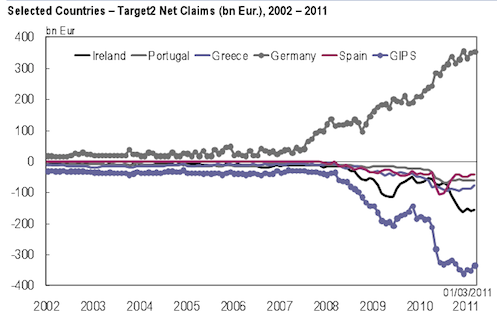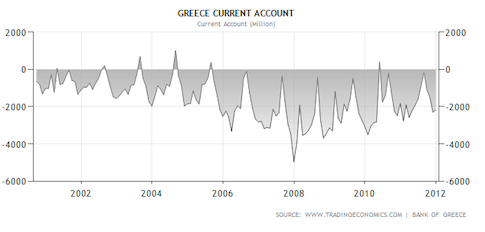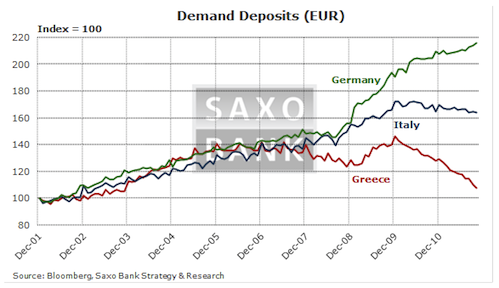
On my post a few days ago a couple of readers made comment about the current attention that is being given to the European TARGET2 system. I thought I would spend a little bit of time discussing the topic as I was given a timely reminder by Bloomberg last night: (emphasis added)
German angst is growing as an entry on the Bundesbank’s balance sheet swells to a sum worth about 20 percent of economic output, a sign of the extent to which Europe’s largest economy is funding the region’s laggards.
The European Central Bank’s Target2 system, which calculates debts between the euro region’s central banks, shows the Bundesbank is owed 489 billion euros ($656 billion), up almost 65 percent from a year earlier. German central bank President Jens Weidmann wrote to ECB President Mario Draghi last month to warn about growing systemic risks, Frankfurter Allgemeine Zeitung newspaper reported Feb. 29.
“There would have been a current-account crisis years ago in a multi currency area,” said Darren Williams, who helps oversee about $420 billion as chief European economist at AllianceBernstein in London. “The periphery is dependent on Germany and the core to fund their consumption.”
I haven’t mentioned the system previously as I consider it to be a technical extension of the European central banks reserve system, but there are some interesting nuances in the system that are worth discussing, even if it is only for educational purposes. Although I will try an keep this discussion as simple as possible the concepts themselves are a little technical so, if you get stuck, I recommend you review some of my earlier articles on reserves and banking operations to remind yourself about some of the concepts.
For those who don’t know TARGET2 stands for Trans-European Automated Real-time Gross Settlement Express Transfer system version2 and is the system used by EuroZone national central banks to record reserve transfers across national borders. For a full description of the system you can read this document , and for further background the original TARGET system document.
There is a lot of details in those documents but from a functional perspective the major sections of interest are:
Article 4 Interlinking Provisions
(a) Description of interlinking
The ECB and each of the NCBs shall operate an interlinking component to enable the processing of cross-border payments within Target. Such interlinking components shall comply with the technical provisions and specifica- tions, which are available on the ECB’s website (www.ecb.int) and updated from time to time.
(b) Opening and operation of inter-NCB accounts held at the NCBs and the ECB
1.The ECB and each of the NCBs shall open an inter-NCB account on their books for each of the other NCBs and for the ECB. In support of entries made on any inter-NCB account, each NCB and the ECB shall grant one another an unlimited and uncollateralised credit facility.
2. To effect a cross-border payment, the sending NCB/ECB shall credit the inter-NCB account of the receiving NCB/ECB held at the sending NCB/ECB; the receiving NCB/ECB shall debit the inter-NCB account of the sending NCB/ECB held at the receiving NCB/ECB.
3. All inter-NCB accounts shall be maintained in the euro unit.
And further information is provided by the ECB’s annual accounts document
Intra-ESCB balances result from cross-border payments in the EU that are settled in central bank money in euro. These transactions are for the most part initiated by private entities (i.e. credit institutions, corporations and individuals). They are settled in TARGET2 – the Trans-European Automated Real-time Gross settlement Express Transfer system – and give rise to bilateral balances in the TARGET2 accounts of EU central banks.
These bilateral balances are netted out and then assigned to the ECB on a daily basis, leaving each NCB with a single net bilateral position vis-à-vis the ECB only. This position in the books of the ECB represents the net claim or liability of each NCB against the rest of the ESCB.
So at the simplest level, if you understand that commercial banks have settlement accounts at their national reserves you can extend that concept to understand that National central banks (NCBs) of Europe have accounts at the ECB through which reserve transfers occur between nations. The difference is that commercial banks have to clear their reserve overdrafts by either borrowing from other banks or the central bank, however national central bank overdrafts within the system are not cleared they are simply recorded in the TARGET2 system.
As you can see from the Bloomberg article above, there appears to be a growing concern in Germany about the balances held within this system.

This concern appears to have been led, in most part, by Hans-Werner Sinn, Professor of Economics and Public Finance at the University of Munich amongst others including some members of the Bundesbank. Prof Sinn has been writing articles, such as this one in which he appears to have a fair grasp of the systemic issues of Europe and the monetary system right up until he makes statements like this one:
To be concrete, the mechanics of the Eurosystem implied that the Bundesbank gave credit to other euro countries at the expense of German banks to the tune of €390 billion (by August 2011) to allow them to crank up the money-printing press to finance their balance of payment deficits.
The premise of Professor Sinn’s argument appears to be that TARGET2 balances show that German banks have been financing current account deficits and by providing these funds the German banking system is suffering. The first point to clarify is that there appears to be absolutely no correlation between the current account data of Greece and the TARGET2 balances. In fact, Greece has been running a constant CAD since it joined the Euro, yet TARGET2 balance discrepancies didn’t start showing up until 2008 which is the time Greece’s CAD actually began to improve.

Martin Wolf from the financial times provides some further analysis of Professor Sinn’s ideas.
… this backdoor way of financing debtor countries cannot continue for very long. By shifting so much of the eurozone’s money creation towards indirect finance of deficit countries, the system has had to withdraw credit from commercial banks in creditor countries. Within two years, he states, the latter will have negative credit positions with their national central banks – in other words, be owed money by them. For this reason, these operations will then have to cease.
I certainly do agree with the Professor that Europe’s problems are structural and stem from the single currency, lack of prudent macroeconomic management and unregulated banking. (For more on this point please see this post ). He does however appear to have a fairly weak understanding of how the central bank operations occur, at least he writes as if he does, which, given his position, makes me wonder a little about his motives. In addition he make statements that appear intentionally divisive yet have no basis in economics. For example:
Today, the Bundesbank converts the “GIPS euros” into “German euros”, which then crowd out the “refinancing-credit-euros” issued by the Bundesbank and instead of foreign currency or foreign assets, the Bundesbank just receives claims on the Eurosystem that it will not be able to convert into anything.
There is absolutely no distinction between a Euro reserve no matter where the computer used to add it is located, they are all the same Euro denominated liabilities of the ECB. There is also no distinction between one Euro reserve and another in terms of its capacity to support refinancing. More importantly Europe is a monetary union, which means Germany was only ever going to receive an electronic balance at the ECB in return for trade with other European nations. That is simply how a modern monetary union works and a suggestion that Greece, or any other EuroZone nation, should hand over something like US dollars or gold in exchange for trade with Germany is very odd to say the least.
Within the Eurozone monetary policy is governed by the European Central Bank yet implemented in a decentralised way through the 17 national central banks. Therefore if Greek commercial bank requires European central bank services these operations are performed by the Greek central bank as a proxy for the ECB. Due to this the ECB’s balance sheet is spread across multiple regions, and so , although in aggregate the ECB’s asset and liabilities will balance, the same is not true for national central banks. The fact is however, that a Euro reserve is a liability of the ECB no matter where it is recorded, and so a positive TARGET2 balance is a claim on the ECB not on an individual national central bank.
To Prof Sinn’s point:
By shifting so much of the eurozone’s money creation towards indirect finance of deficit countries, the system has had to withdraw credit from commercial banks in creditor countries. Within two years, he states, the latter will have negative credit positions with their national central banks – in other words, be owed money by them. For this reason, these operations will then have to cease.
As I explained above national central banks provide ECB services to commercial banks working within their region. If a customer of a Greek bank requests for some of their deposits to be transferred to a German bank then this transfer will be require the movement of reserves from the Greek central bank to the German central bank. In doing so the Greek central bank will incur a TARGET2 liability while the German central bank will gain a TARGET2 claim. However it must be understood at a aggregated level TARGET2 balances net to zero.
As you may remember from my Macro 101 series banks that lose reserves via interbank transaction often need to re-coup them in order to a) satisfy their legal reserve requirements ( not relevant to Australia ) and; b) meet the demands of future interbank transactions. To do this they can borrow from other commercial banks within the same monetary system ( sometime across national borders ) or failing that a central bank. If a Greek bank borrowed from a German bank in order to re-coup reserves you would see the reverse of the transaction above. That is, the German central bank would incur a TARGET2 liability while the Greek central bank a claim.
Obviously you can see that the daily operations of the European banking system causes TARGET2 balances to fluctuate, but the expectation is that under normal circumstances these balances would approach zero. So what would cause a build up of liabilities and claims in the TARGET2 system? Well if we think about the situation in which a customer of a Greek bank sends money to a German bank yet the Greek bank is unable to re-coup the lost reserves in the interbank market. In this case the bank lends directly from the Greece central bank. You may remember I discussed this scenario in a previous post on European inter-bank stress , although it should noted that direct central bank lending isn’t always a sign of stress in the banking system.
If, however, this situation continues for a period of time then there would be a growing TARGET2 liability from the Greek national bank, along with a growing TARGET2 claim with the German national bank.
You would also see a demand deposit chart that looked remarkably like this one.

Does this somehow mean that German commercial banks are unable to provide lending services to the German economy ? No, because a commercial German bank can always borrow reserves from the interbank market and, failing that, directly from the German central bank. Under this scenario Professor Sinn claims that TARGET2 balances will somehow stop the German central bank being able to process such requests. But as we all know these are electronic operations, performed by simply adding some more numbers to an account in a central bank computer.
There is absolutely no way the German central bank can ever refuse this request for reserves from a commercial bank because by doing so the interest rate in the German interbank market would quickly shoot upwards outside the ECB’s target range as banks began to fight over reserves. That is, if the ECB is attempting to maintain an interest rate then its proxy national central banks have no choice but to provide reserves in exchange for eligible assets because failing to do so would quickly escalate into a banking crisis and destabilise the EuroZone.
What makes this more odd is that under this scenario German banks would be receiving and holding additional reserves, which is the exact opposite of the problem Professor Sinn describes. This raises my suspicions that Professor Sinn, like so many other Germans, has concerns stemming from worries about inflation due to excess reserves more than the issue he is actually describing.
The other point I believe Professor Sinn is alluding to is that the German central bank is at risk of huge losses if one of the periphery nations becomes insolvent. This is obviously a valid concern, however as I explained above the claims and liabilities recorded in the TARGET2 system are liabilities of the ECB not of one specific national central bank. If one of the EuroZone nations does somehow default on its obligations, possibly by leaving the monetary union, then the cost of that obligation will be worn by all EuroZone nations equal to their ECB capital share. That is, Italy is as proportionally as much on the hook for Greece as is Germany.
So does the TARGET2 system provide evidence that Germany is funding the periphery current accounts and is therefore a risk to the ability of the German banking system to perform ?
No.
Is the imbalance in the TARGET2 system a concern?
Yes, but not for the reasons specified by Professor Sinn. What the TARGET2 imbalance shows is that there continues to be capital flight out of the periphery banking system towards the core, and this in itself is a very destabilising and dangerous.
Should we be listening to Professor Sinn?
Probably not. Although I do agree with him about the root causes of the Europe’s financial crisis, his diagnosis appears to contain either mis-information or lack of understanding of the functions of the monetary system. This suggests he is either working to an ideology or doesn’t truly understand the subject matter. Either way , his proposed solutions are therefore likely to be more dangerous than constructive while the unnecessary attention given to TARGET2 balances is distracting Europe away from solving its problems.